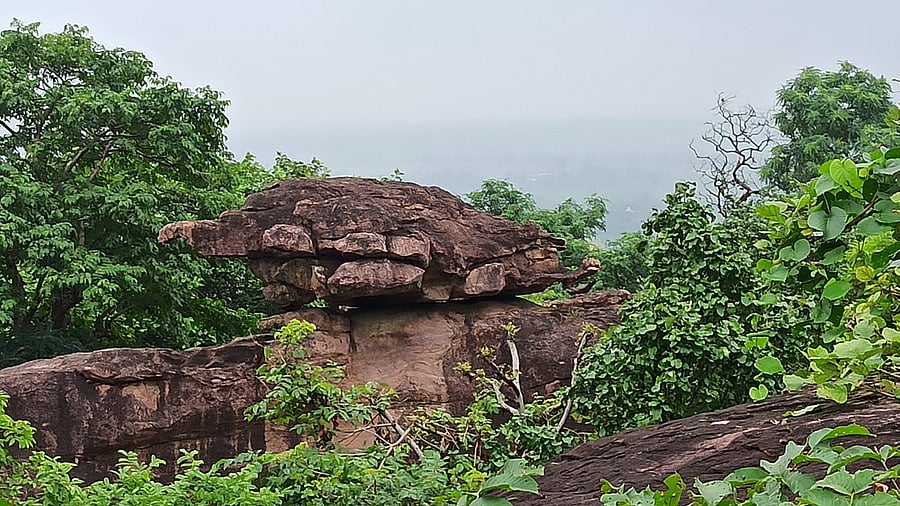
Bhimbetka
Credit: Special arrangement/Mrityunjay Bose
Standing before the Rock Shelters of Bhimbetka evokes memories of school textbooks, and as one ventures deeper, it feels like stepping into a time machine that transports you back over one hundred thousand years and more.
The rock shelters and their paintings tell the story of human evolution, illustrating the transition from ‘adimanav’ to ‘adivasi’.
A two-hour stroll through these ancient, naturally sculpted rocks enveloped by lush forests, ignites a child-like wonder in visitors, encouraging a deeper exploration of history and prehistory.
Home to India’s oldest known rock art, Bhimbetka is one of the world’s largest prehistoric complexes, recognised as a UNESCO World Heritage Site, thanks to the tremendous efforts of the Archaeological Survey of India (ASI).
The paintings in Bhimbetka, crafted using natural pigments, have remarkably endured through the ages. This site showcases the gradual progression of intelligence in early humans.
Comprising seven hills, the area features over 750 rock shelters, of which approximately 400 are adorned with paintings, though only about a dozen are open to the public daily.
Located about 45 km from Bhopal towards Hoshangabad, the cave complex resides in the Raisen district of Madhya Pradesh, which is vital to India’s archaeological and geological heritage. Nestled within the Ratapani Wildlife Sanctuary, a dry deciduous forest bordering the Vindhyachal mountain ranges and near the Satpura mountain ranges, the site lies close to the Betwa and Narmada rivers.
“It holds significant importance across various fields — archaeology, geology, anthropology, palaeography, tourism, and biodiversity. Future discoveries are likely,” remarked Ravi Kumar Yadav, a tourist guide who leads tours in Bhimbetka.
“The caves of Bhimbetka were uncovered in 1957–58 by the renowned archaeologist Vishnu Shridhar Wakankar and designated as a UNESCO World Heritage Site in 2003,” stated Yadav, whose father collaborated with Dr Wakankar for nearly a decade.
The site spans the Upper Paleolithic, Mesolithic, Chalcolithic, Early Historic, and Medieval periods, connecting to various epochs. Most rock paintings are believed to date from the Mesolithic era.
“These shelters document the evolution of human settlement from hunter-gatherers to agricultural societies, reflecting ancient cultures,” he added.
“It’s astonishing. As I traversed the complex, I observed layers of prehistory and history unfolding before me. It’s a unique experience. The intelligence of early humans is evident. The paintings, created millennia ago, are still visible. Over time, we also see layers of superimposed artworks,” shared Vijay Gaikwad, a writer and agricultural expert from Mumbai.
“The rock art acts as a historical record, like a gazette capturing the essence of those eras,” he further explained.
The caves were inhabited from 100,000 BC to 1000 AD, with the oldest paintings estimated to be around 30,000 years old, underscoring the site’s global significance.
“The subject matter at Bhimbetka is incredibly diverse, depicting various life aspects from ancient to later periods, including humans, animals, human-animal interactions, battles, hunting scenes, and spiritual symbols such as group dances, rituals, mythology, nature, and material culture,” Yadav noted, mentioning that stone tools like handaxes, spears, cleavers, and pebble tools are also represented in the paintings.
“The cultural traditions of the 21 villages neighbouring the site closely mirror those depicted in the rock art,” as stated on the UNESCO website.
Did you know?
♦ Bhimbetka is rich in natural resources — perennial water sources, natural shelters, and diverse forest flora and fauna. Similar to regions known for significant rock art, such as Kakadu National Park in Australia or Kondoa Irangi in Tanzania, these favourable conditions likely facilitated the development of sustainable societies and remarkable rock art.
♦ The name Bhimbetka derives from the Hindi phrase Bhim-baithka, meaning the seat or resting place of the mighty Bhim, one of the Pandava brothers — Yudhishtir, Bhim, Arjun, Nakul, and Sahadev — who are central figures in the Mahabharata.
♦ The Ratapani Wildlife Sanctuary spans 825.90 sq km and is celebrated for its unique biodiversity, housing a variety of animals including tigers, panthers, sloth bears, wolves, hyenas, foxes, jackals, swamp deer, antelope, blue bulls, stags, and porcupines. Reptiles such as pythons, cobras, kraits, vipers, and monitor lizards are plentiful. Numerous bird species can also be observed, including common babblers, crimson-breasted barbets, bulbuls, bee-eaters, bayas, cuckoos, kingfishers, kites, larks, Bengal vultures, sunbirds, white wagtails, crow pheasants, jungle crows, egrets, mynas, jungle fowls, parakeets, partridges, hoopoes, quails, woodpeckers, blue jays, doves, black drongos, flycatchers, flowerpeckers, and rock pigeons. Ratapani features both dry and moist deciduous forests, with teak being the predominant tree species.